John Hurrell – 14 January, 2011
What Johnston has done in the ‘Bogle Room' is extremely interesting, with some of the original works re-exhibited, and some TV films made about the shows and their artists. However a lot of other very capable curators have also worked in this space and a show looking at the tastes and personalities of these creative individuals would have been immensely rewarding.
Auckland
Call Waiting: A Celebration of the New Gallery 1995 - 2011
Curated by Alexa Johnston
20 November 2010 - 30 May 2011
It is nearly halfway through January, and 2011 is racing along at an unbelievable rate. In a blink of an eye it will be June and Auckland Art Gallery will be opening its massive new suite of galleries, offices, lounge and amphitheatre - and the New Gallery (it seems) abandoned.
Alexa Johnston was one of the key personalities involved in setting up the programme of the New Gallery after its conversation from the old Telephone Exchange building in 1995, so it is interesting through this exhibtion to have the chance to get her take on the project. She worked at the Auckland Art Gallery for nineteen years, and left after the New Gallery had been going for six - so it would have been valuable to get some overall evaluation.
That doesn’t really happen. Most of the space is devoted to her personal picks out of the Auckland Art Gallery Collection, and not that much to the history of this particular exhibiting space. Only the staircase entrance and one room running off it focus on the subject.
Those rooms succeed well. One gallery is devoted to the curatorial achievements of the curator Andrew Bogle and the other has works pertaining to the Telephone Exchange building (such as Ralph Paine’s exciting set of five banners from which the exhibition’s title has been taken), a vitrine of magazine articles about the building’s architecture and shows, and a projected sequence of slides of the changes needed to make the space ‘art-worthy’, and all the shows presented so far.
What Johnston has done in the ‘Bogle Room’ is fascinatingly informative (Bogle did three very popular exhibtions in the New Gallery: Patterns of Paradise: Cook Islands Tivaevae [1995], Ndebele: African Art in the Making [1998], and Transformers: a Moving Experience [1996]) with some of the original works re-exhibited, and the presentation of three TV films made about the shows and their artists, exhibitions rarely talked about now. However a lot of other very capable curators have also worked in the New Gallery (such as Robert Leonard, William McAloon, Natasha Conland, Ron Brownson, Ngahiraka Mason, Allan Smith and Mary Kisler) - some of these still are - and a show looking at the tastes and personalities of these creative individuals, their approaches to assembling shows, would have been immensely rewarding. It would have given the exhibition focus by sustaining a detailed examination of how the New Gallery functioned for the organisers and planners of displays: the pragmatics of the space.
Still what Johnston has done with Bogle’s exhibitions is oddly intriguing in its paradox, as the Transformers documentation (a Shirley Horrocks film) emphasises kinetic works that move; something not seen elsewhere in the current show and revealing of its limitations.
With her selection from the collection the main theme gets sidetracked. Picking out her favourite items, Johnston emphasises overall the South Pacific content, with brilliant choices of work from Sofia Tekela Smith (examining the dignity of the human face), Niki Hastings-McFall (ridicule of unwelcome visitors), Jacqueline Fraser (a sense of place and history) and Joe Sheehan (spirituality and the land).
There is also the spontaneous clowning of Tom Kreisler, where a white enamel jug becomes the artist’s head through deft use of a thin-tipped brush and black paint, a container for the mixing up and pouring out of ideas.
Probably the main crowd-pleaser is Peter Madden’s admonitory Necrolopolous, an intricate, black, vaguely rectangular structure symbolising a doomed city. Dense with a concentration camp’s high barbed wire fences, teetering watchtowers, complex rickety scaffolding and loaded up platforms, this sinister yet whimsical construction is packed with detail. It has all the usual sculpturally ‘collaged’ Madden layering of suspended cut-out paper birds, mammals, insects and bones. Death and life: side by side and intermingled.
John Hurrell
Recent Comments
John Hurrell
The Kreisler work here, and the survey at the Govett and Artspace, http://eyecontactartforum.blogspot.co.nz/2007/12/tom-kreisler.html are both good reminders of Tom's contribution ...
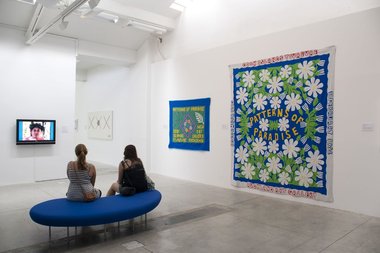





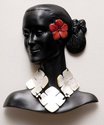
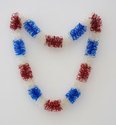

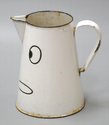
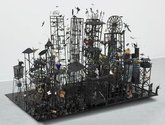
 Two Rooms presents a program of residencies and projects
Two Rooms presents a program of residencies and projects Advertising in this column
Advertising in this column



This Discussion has 1 comment.
Comment
John Hurrell, 5 p.m. 30 June, 2015 #
The Kreisler work here, and the survey at the Govett and Artspace, http://eyecontactartforum.blogspot.co.nz/2007/12/tom-kreisler.html are both good reminders of Tom's contribution to our visual art culture. Shirley Horrocks' film 'Tom Who? The Enigma of Tom Kreisler' is awaited with eager anticipation. It will have three screenings at the coming film festival.
http://www.pointofview.co.nz/TomKreisler.htm
Participate
Register to Participate.
Sign in
Sign in to an existing account.